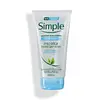What's inside
What's inside
 Key Ingredients
Key Ingredients

 Benefits
Benefits

 Concerns
Concerns

 Ingredients Side-by-side
Ingredients Side-by-side

Water
Skin ConditioningGlycerin
HumectantDipropylene Glycol
HumectantSodium Cocoamphoacetate
CleansingChondrus Crispus
MaskingPotassium Cocoyl Glycinate
Sodium Lauroyl Sarcosinate
CleansingPotassium Cocoate
EmulsifyingDecyl Glucoside
CleansingSodium Polyacrylate
AbsorbentPropanediol
SolventXanthan Gum
EmulsifyingTrehalose
HumectantDipotassium Glycyrrhizate
HumectantSodium Lauroyl Glutamate
Acacia Senegal Gum
MaskingDecylene Glycol
Skin ConditioningGlyceryl Caprylate
EmollientSerenoa Serrulata Fruit Extract
Skin ConditioningCinnamomum Cassia Bark Extract
MaskingHydrated Silica
AbrasiveButylene Glycol
HumectantBetaine
HumectantSapindus Mukorossi Peel Extract
Skin ConditioningPanthenol
Skin ConditioningSodium PCA
HumectantChondrus Crispus Extract
Skin Conditioning1,2-Hexanediol
Skin ConditioningEscin
TonicSorbitol
HumectantThreonine
Arginine
MaskingLysine
Skin ConditioningAlanine
MaskingGlutamic Acid
HumectantGlycine
BufferingSerine
MaskingProline
Skin ConditioningRuscus Aculeatus Root Extract
AstringentAmmonium Glycyrrhizate
MaskingPhenoxyethanol
PreservativeCentella Asiatica Leaf Extract
Skin ConditioningHydrolyzed Yeast Protein
Skin ConditioningCalendula Officinalis Flower Extract
MaskingHydroxyacetophenone
AntioxidantGluconolactone
Skin ConditioningSodium Citrate
BufferingSodium Benzoate
MaskingSodium Hyaluronate
HumectantWater, Glycerin, Dipropylene Glycol, Sodium Cocoamphoacetate, Chondrus Crispus, Potassium Cocoyl Glycinate, Sodium Lauroyl Sarcosinate, Potassium Cocoate, Decyl Glucoside, Sodium Polyacrylate, Propanediol, Xanthan Gum, Trehalose, Dipotassium Glycyrrhizate, Sodium Lauroyl Glutamate, Acacia Senegal Gum, Decylene Glycol, Glyceryl Caprylate, Serenoa Serrulata Fruit Extract, Cinnamomum Cassia Bark Extract, Hydrated Silica, Butylene Glycol, Betaine, Sapindus Mukorossi Peel Extract, Panthenol, Sodium PCA, Chondrus Crispus Extract, 1,2-Hexanediol, Escin, Sorbitol, Threonine, Arginine, Lysine, Alanine, Glutamic Acid, Glycine, Serine, Proline, Ruscus Aculeatus Root Extract, Ammonium Glycyrrhizate, Phenoxyethanol, Centella Asiatica Leaf Extract, Hydrolyzed Yeast Protein, Calendula Officinalis Flower Extract, Hydroxyacetophenone, Gluconolactone, Sodium Citrate, Sodium Benzoate, Sodium Hyaluronate
Water
Skin ConditioningCocamidopropyl Betaine
CleansingPropylene Glycol
HumectantHydroxypropyl Methylcellulose
Emulsion StabilisingSodium Chloride
MaskingPanthenol
Skin ConditioningCitric Acid
BufferingDisodium EDTA
Glycerin
HumectantHydroxypropyl Cyclodextrin
MaskingIodopropynyl Butylcarbamate
PreservativePantolactone
HumectantPhenoxyethanol
PreservativePotassium Chloride
Saccharide Isomerate
HumectantSodium Citrate
BufferingSodium Hydroxide
BufferingTocopheryl Acetate
AntioxidantWater, Cocamidopropyl Betaine, Propylene Glycol, Hydroxypropyl Methylcellulose, Sodium Chloride, Panthenol, Citric Acid, Disodium EDTA, Glycerin, Hydroxypropyl Cyclodextrin, Iodopropynyl Butylcarbamate, Pantolactone, Phenoxyethanol, Potassium Chloride, Saccharide Isomerate, Sodium Citrate, Sodium Hydroxide, Tocopheryl Acetate
 Reviews
Reviews

Ingredients Explained
These ingredients are found in both products.
Ingredients higher up in an ingredient list are typically present in a larger amount.
Glycerin is already naturally found in your skin. It helps moisturize and protect your skin.
A study from 2016 found glycerin to be more effective as a humectant than AHAs and hyaluronic acid.
As a humectant, it helps the skin stay hydrated by pulling moisture to your skin. The low molecular weight of glycerin allows it to pull moisture into the deeper layers of your skin.
Hydrated skin improves your skin barrier; Your skin barrier helps protect against irritants and bacteria.
Glycerin has also been found to have antimicrobial and antiviral properties. Due to these properties, glycerin is often used in wound and burn treatments.
In cosmetics, glycerin is usually derived from plants such as soybean or palm. However, it can also be sourced from animals, such as tallow or animal fat.
This ingredient is organic, colorless, odorless, and non-toxic.
Glycerin is the name for this ingredient in American English. British English uses Glycerol/Glycerine.
Learn more about GlycerinPanthenol is a common ingredient that helps hydrate and soothe the skin. It is found naturally in our skin and hair.
There are two forms of panthenol: D and L.
D-panthenol is also known as dexpanthenol. Most cosmetics use dexpanthenol or a mixture of D and L-panthenol.
Panthenol is famous due to its ability to go deeper into the skin's layers. Using this ingredient has numerous pros (and no cons):
Like hyaluronic acid, panthenol is a humectant. Humectants are able to bind and hold large amounts of water to keep skin hydrated.
This ingredient works well for wound healing. It works by increasing tissue in the wound and helps close open wounds.
Once oxidized, panthenol converts to pantothenic acid. Panthothenic acid is found in all living cells.
This ingredient is also referred to as pro-vitamin B5.
Learn more about PanthenolPhenoxyethanol is a preservative that has germicide, antimicrobial, and aromatic properties. Studies show that phenoxyethanol can prevent microbial growth. By itself, it has a scent that is similar to that of a rose.
It's often used in formulations along with Caprylyl Glycol to preserve the shelf life of products.
Sodium Citrate is the sodium salts of citric acid. In skincare, it is used to alter pH levels and acts as a preservative.
Its main functions are to maintain the pH of a product and neutralize metal ions.
The acidity of our skin is maintained by our glands and skin biome; normal pH level of skin is slightly acidic (~4.75-5.5).
Being slightly acidic allows our skin to create an "acid mantle". This acid mantle is a thin barrier that protects our skin from bacteria and contaminants.
Learn more about Sodium CitrateWater. It's the most common cosmetic ingredient of all. You'll usually see it at the top of ingredient lists, meaning that it makes up the largest part of the product.
So why is it so popular? Water most often acts as a solvent - this means that it helps dissolve other ingredients into the formulation.
You'll also recognize water as that liquid we all need to stay alive. If you see this, drink a glass of water. Stay hydrated!
Learn more about Water